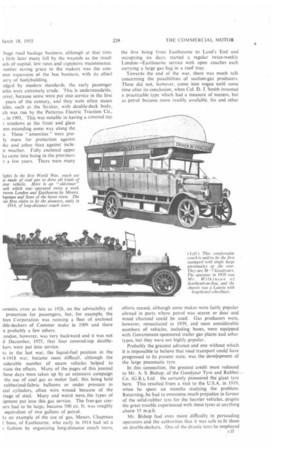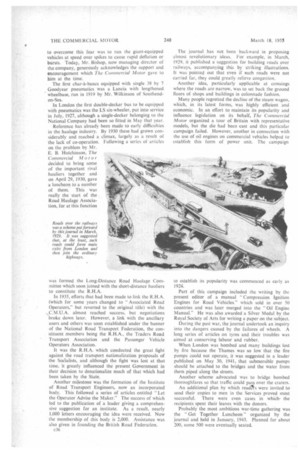MILESTONES
Page 176

Page 177

Page 178

If you've noticed an error in this article please click here to report it so we can fix it.
Some of the Chief Activities, in Certain of Which This Journal Took a Prominent Part, Which have Marked Road Transport Progress by G. Mackenzie Junner,
M.I.R.T.E.
HURSDAY, March 16, 1905, was a particularly
momentous time for the appearance of The Com mercial Motor, for it was on March 21 that its founder. Mr. Edmund Danger&Id, attended a luncheon given by the Motor Van and Wagon Users Association to commemorate the coming into force of the Heavy Motor Car Order, 1904. This permitted heavy vehicles on soft tyres to travel at 12 m.p.h. and have a width of 7 ft. 6 in.
The Association was actually founded on November 5, 1903, later the name was changed to the Motor Van, Wagon and Omnibus Users Association, and in 1907 to The Commercial Motor Users Association. It
was this body which, with the first editor of The Commercial Motor, who later became its president,
performed such valuable service in fighting for the cause of road transport, strongly backed by the journal.
Early in 1907 the C.M.U.A. began to organize competitive parades for all classes of commercial vehicle, the first being held on the Thames Ernbankment in December of that year, all: the 26 entries being steam vehicles with steel tyres.
Perhaps the most important of these events was the Coronation Parade of 1911, but the biggest was in 1914, when over 500 vehicles parade on the Embankment early on the Whit-Monday.
An important influence was exercised by the commercial vehicle trials of 1907, in which the C.M.U.A. co-operated with the Royal Automobile Club. They extended over five weeks and included 56 vehicles which took part in a circular tour of the country. These trials, which were really a vindication of the business vehicle, aroused great interest and helped to improve design.
In the same year was held the first International Commercial Motor Exhibition at Olympia. Previous to that commercial vehicles were exhibited as a section of the Motor Show.
It was the 1914-18 war, however, which proved to the world the reliance which could be placed upon mechanical transport by road.
Some years before, the War Office, in conjunction with the manufacturers, had devised a subsidy scheme by which certain makes and types of vehicle were passed as meeting its fairly exacting requirements, and their operators were given an annual subsidy provided that they were kept in good condition and immediately available for active service. Modifications in the scheme were made as necessary and there is no doubt that this exercised an important influence upon commercialvehicle design.
These few vehicles could not, however, meet the need, and thousands of others were requisitioned, including hundreds of what were then the familiar London General B-type buses complete with their advertisements and destination signs.
Soon after hostilities ceased, the Government flooded the market with their surplus transport and thus brought an intense gloom to the vehicle manufacturers, which was later accentuated by a general trade depression, lasting six years or more, until these used vehicles had to be replaced and more buyers took heart.
There was, however, one alleviating circumstance. Many hundreds of men from the Services had bought lorries and thusformed the nucleus of what isnow
huge road haulage business, although at that time little later many fell by the wayside as the result ack. of capital, low rates and expensive maintenance. mother saving grace to the makers was the conLous expansion of the bus business, with its allied istry of bodybuilding.
idged by modern standards, the early passenger ides were extremely crude. This is understandable, /ever, because some were put into service in the first years of the century, and they wete often steam ides, such as the Straker, with double-deck body, ch was run by the Potteries Electric Traction Co., ., in 1901. This was notable in having a covered lop
windows at the front. and glass ens extending some way along the s. These " amenities " were proly more for protection against rke and ashes than against incleit weather. Fully enclosed upper ks came into being in the provinces 1a few years, There were many
uments, even as late as 1926, on the advisability of protection for passengers, but, for example, the Ines Corporation was running a fleet of enclosed ible-deckers of Commer make in 1909 and there e probably a few others.
.ondon, however, was very backward and it was not il December, 1925, that four covered-top doublekers were put into service.
ts in the last war, the liquid-fuel position in the 4-1918 war, became most difficult, although the siderable number of steam vehicles helped to viate the effects. Many of the pages of this journal .hose days were taken up by an extensive campaign the use of coal gas as motor fuel; this being held rubberized-fabric balloons or under pressure in cial cylinders, often wire wound because of the riage of steel. Many and weird were.the types of iipment put into this gas service. The free-gas coniers had to be large., because 500 Cu. ft, was roughly equivalent of two gallons of petrol.
s an example of the use of gas, Messrs. Chapman 1 Sons, of Eastbourne. who early in 1914 had sel a r fashion by organizing long-distance coach tours, the first being from Eastbourne to Land's End and occupying six days, started a regular twice-weekly London—Eastbourne service with open coaches each carrying a large gas bag in a roof tray.
Towards the end of the war, there was much talk concerning the possibilities of suction-gas producers. These did not, however, come into vogue until some time after its conclusion, when Col. D. J. Smith invented a practicable type which had a measure of success, but as petrol became more readily available, his and other efforts ceased, although some makes were fairly popular abroad in parts where petrol was scarce or dear and wood charcoal could be used. Gas producers were, however, resuscitated in 1939, and soon considerable numbers of vehicles, including buses, were equipped with Government-sponsored trailer gas plants and other types, but they were not highly popular.
Probably the greatest advance and one without which it is impossible to believe that road transport could have progressed to its present state, was the development of the large pneumatic tyre.
In this connection, the greatest credit must redound to Mr. A. S. Bishop, of the Goodyear Tyre and Rubber-Co. (G.B.), Ltd. He certainly pioneered the giant tyre here. This resulted from a visit to the U.S.A. in 1919, when he spent six months studying the problem. Returning, he had to overcome much prejudice in favour of the solid-rubber tyre for the heavier vehicles, despite the great trouble experienced with these tyres at anything above 15 m.p.h.
Mr. Bishop had even more difficulty in persuading operators and the authorities that it was safe to fit them on double-deckers. One or the drastic tests he employed c35 to overcome this fear was to run thc giant-equipped vehicles at speed over spikes to cause rapid deflation or bursts. Today, Mr. Bishop, now managing director of the company, generously acknowledges the support and encouragement which The Commercial Motor gave to him at the time.
The first char-h-bancs equipped with single 38 by 7 Goodyear pneumatics was a Lancia with lengthened wheelbase, run in 1919 by Mr. Wilkinson of Southendon-Sea.
In London the first double-decker bus to be equipped with pneumatics was the LS six-wheeler, put into service in July, 1927, although a single-decker belonging to the National Company had been so fitted in May that year.
Reference has already been made to early difficulties in the haulage industry. By 1930 these had grown considerably and reached a climax, largely as a result of the lack of co-operation. Following a series of articles on the problem by Mr.
E. B. Hutchinson, The Commercial Motor decided to bring some of the important rival hauliers together and on April 29, 1930, gave a luncheon to a number of them. This was really the start of the Road Haulage Association, for at this function was formed the Long-Distance Road Haulage Committee which soon joined with the short-distance hauliers to constitute the R.H.A.
In 1935, efforts that had been made to link the R.H.A. (which for some years changed to Associated Road Operators," but reverted to the original title) with the C.M.U.A. almost reached success, but negotiations broke down later. However, a link with the ancillary users and others was soon established under the banner of the National Road Transport Federation, the constituent members being the R.H.A., the Traders Road Transport Association and the Passenger Vehicle Operators Association.
It was the R.H.A. which conducted the great light against the road transport nationalization proposals of the Socialists, and although the fight was lost at that time, it greatly influenced the present Government in their decision to denationalize much of that which had been taken by the State.
Another milestone was the formation of the Institute of Road Transport Engineers, now an incorporated body. This followed a series of articles entitled "Let the Operator Advise the Maker." The success of which led to the publication of a leader giving a comprehensive suggestion for an institute. As a result, nearly 1,000 letters encouraging the idea were received. Now the membership of this body is 2,000. Assistance was also given in founding the British Road Federation.
c36 The journal has not been backward in proposing almost revolutionary ideas. For example, in March, 1929, it published a suggestion for building roads over railways, accompanying this by striking illustrations. It was pointed out that even if such roads were not carried far, they could greatly relieve congestion.
Another idea, particularly applicable at crossings where the roads are narrow, was to set back the ground floors of shops and buildings in colonnade fashion.
Many people regretted the decline of the steam wagon, which, in its latest forms, was highly efficient and economic. In an effort to maintain its popularity and influence legislation on its behalf, The Commercial Motor organized a tour of Britain with representative models, but the die had been cast and this particular campaign failed. However, another in connection with the use of oil engines on commercial vehicles helped to establish this form of power unit. The campaign
to establish its popularity was commenced as early as 1924.
Part of this campaign included the writing by the present editor of a manual "Compression Ignition Engines for Road Vehicles," which sold in over 50 countries and was later merged into the "Oil Engine Manual." He was also awarded a Silver Medal by the Royal Society of Arts for writing a paper on the subject.
During the past war, the journal undertook an inquiry into the dangers caused by the failures of wheels. A long series of articles on tyres and their troubles was aimed at conserving labour and rubber.
When London was bombed and many buildings lost by fire because the Thames was so low that the fire pumps could not operate, it was suggested in a leader published on May 30, 1941, that submersible pumps should be attached to the bridges and the water from them piped along the streets.
Another scheme advocated was to bridge bombed thoroughfares so that traffic could pass over the craters. An additional plan by which read& were invited to send their copies to men in the Services proved most successful. There were even cases in which the recipients spent their leaves with the donors.
Probably the most ambitious war-time gathering was the "Get Together Luncheon " organized by the journal and held in January, 1943. Planned for about 200, sonic 500 were eventually seated.








































































































































































































































































